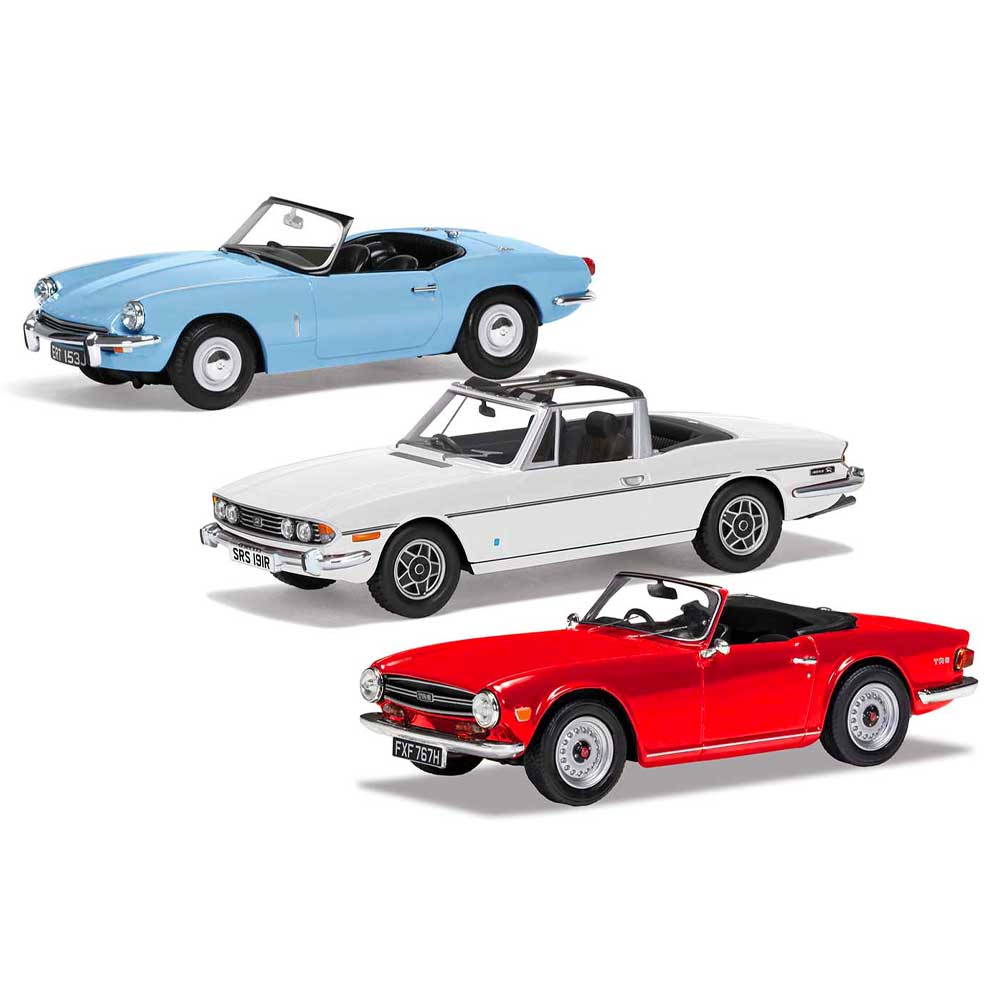Triumph Topless CollectionPost-war, Triumph had become moribund when, in 1945, their Coventry neighbour Standard purchased them to utilize their prewar reputation for fine sporting and luxury cars. Standard-Triumph, as they later became, launched the TR2 in 1953 to immediatesales and motorsport success. Subsequent TR models evolved until the last ‘separate-chassis’ TR6, was produced in 1976.The smaller 1962 Herald-based Spitfire emulated that success until production ceased in 1980, while the beautiful 1970 Stagwas a car with the panache and performance needed to succeed in the luxury GT market. These models reflect the three familiesof sporting car emerging from Triumph’s Canley factory during an era when the company were triumphant on road and trackTriumph Spitfire Mk3 Wedgwood Blue Length 84mmThe Spitfire was announced at the 1962 Earls Court Motor Show and would remain in production, with four distinct updates, until 1980 by which time 314,332 had beenmade. It was based on the Herald, the company’s small saloon for the 1960s, a car which, unfashionably at the time, was built on a separate chassis allowing them tovery easily create various models for different markets including the Vitesse, GT6 and Courier van. The Spitfire was created to compete with BMC’s Austin Healey Spriteand MG Midget twins but was just a little bit larger, making it a more practical touring car.Triumph Stag Mk2 White Length 101mmStylist Walter Belgrove resigned from Standard-Triumph in late 1955 leaving the company with a void in the styling department which was not filled until, by a seriesof coincidences, they began to work with Italian genius Giovanni Michelotti in late 1956. By 1965 his relationship with Triumph was so strong that when he requesteda 2000 saloon as a basis for a one-off show-car, one of the Le Mans team’s support vehicles was driven to his Turin studio after the race. When Triumph executivessaw the show-car being built, they were so impressed they bought the design and it became the StagTriumph TR6 Signal Red Length 92mmMichelotti did, though, become a victim of his own success, so much so that he simply did not have the capacity to undertake an update of the TR5’s styling because ofthe work he was doing for both Triumph and the company that had bought them in 1960, truck manufacturers Leyland Motors. German coachbuilders Karmann weretherefore given the job of modernising the TR5 bodyshell while retaining the scuttle, doors and interior packaging. The resulting 1968 TR6 was considered very successfulby company and public alike and, although it proved to be the last separate chassis TR, it remained in production until July 1976
£108.99 Original price was: £108.99.£98.09Current price is: £98.09.
In stock
| Weight | 1.91 kg |
|---|
- Royal Mail Tracked (Standard)** (£3.89) 2-3 Working Days***
- Royal Mail Tracked (Express)** (£5.99) 1-2 Working Days***
- FedEx (£8.99) Next Working Day***
- Free – 2-6 Working Days*
** Limited to maximum weight of 2kg
*** These are not guaranteed delivery times and delays are possible
*Free delivery is subject to restrictions, orders between £60-£99.99 containing products that can only shipped with Royal Mail. Orders that include products like aerosols, large quantity of flammable products or over maximum size and weight allowed by Royal Mail will not be sent free and are subject to a carriage charge, Orders over £100 are not subject to restrictions and apply to UK Mainland only. Orders containing hazardous or oversized goods cannot be shipped to NI, IOM, IOW, Highlands, these are excluded from our free shipping.
Order cutoff times - Monday 11am, Tuesday to Friday 12pm.
Order processing days Monday-Friday
Working days are Monday to Friday and do not include weekends


